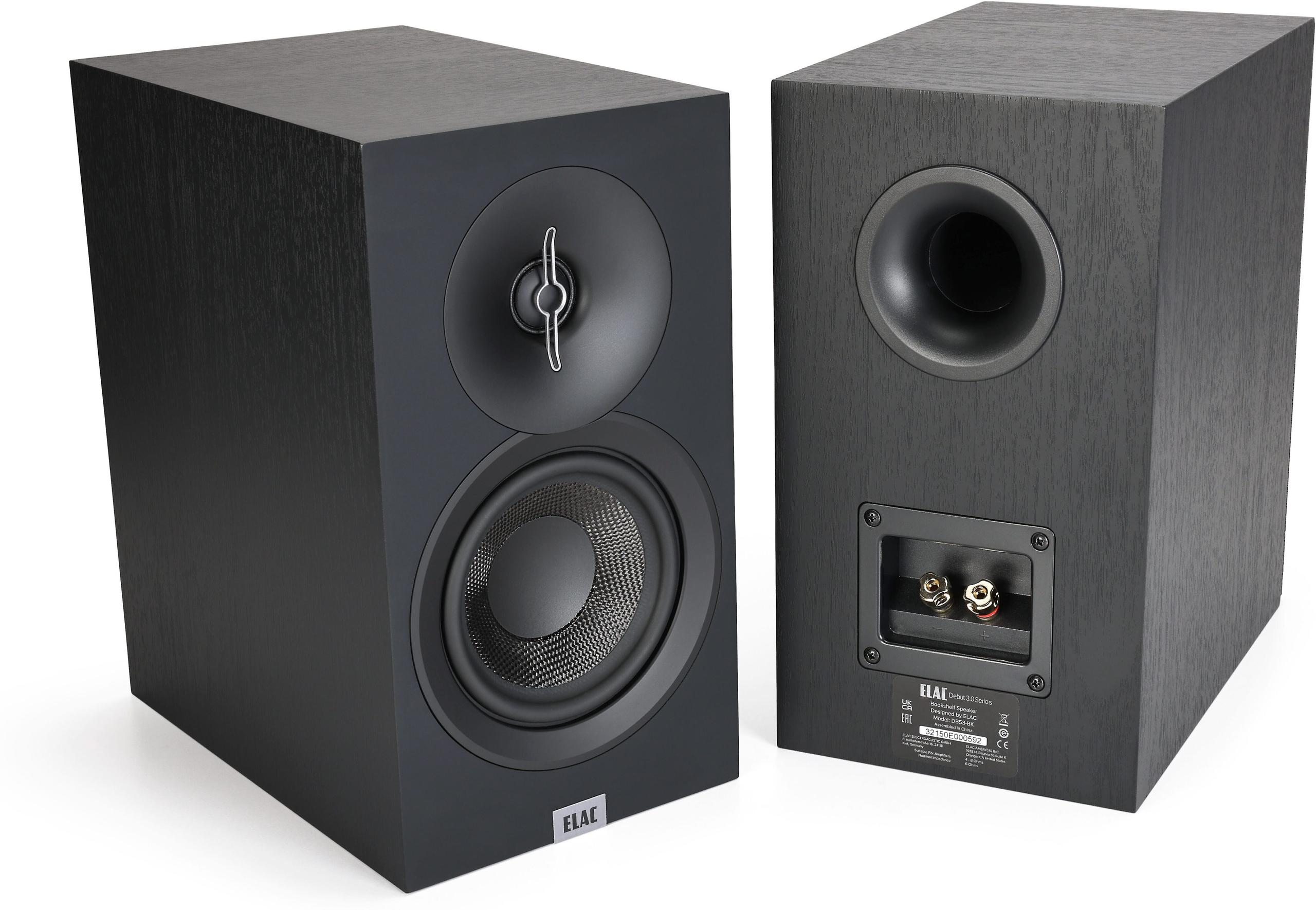
Whether you're building your first serious audio system or upgrading an existing setup, choosing the right bookshelf speakers can feel overwhelming. Today, we're comparing two popular options: the brand new ELAC Debut 3.0 DB53 ($332) and the established SVS Prime Bookshelf Speakers ($299).
Bookshelf speakers are compact but capable audio components designed to excel in small to medium rooms. They're called "bookshelf" speakers because they can literally fit on a bookshelf, though they often perform best on dedicated stands about 2-3 feet from walls.
These speakers serve as the foundation of many high-quality audio systems, whether for pure music enjoyment or as part of a home theater setup. While they won't shake your house like tower speakers, modern bookshelf speakers can deliver remarkably full, detailed sound that surprises many listeners.
The SVS Prime Bookshelf Speakers were introduced in 2015 and quickly became a benchmark for value. They use traditional but well-executed design principles: a 1-inch aluminum dome tweeter (which handles high frequencies) paired with a 6.5-inch woofer (for mid and low frequencies).
In contrast, the ELAC Debut 3.0 DB53 represents the latest speaker technology, announced in 2024. ELAC has incorporated several innovations, including a newly designed aluminum dome tweeter and an advanced aramid fiber woofer (aramid is a super-strong synthetic fiber, similar to what's used in bulletproof vests).
The technical specifications tell an interesting story about how these speakers perform in real-world conditions:
The ELAC DB53 has a 6-ohm impedance (electrical resistance) and 86.5dB sensitivity (how efficiently it converts power to sound). This means it works best with quality amplifiers providing at least 50 watts per channel.
The SVS Prime features an 8-ohm impedance and 87dB sensitivity, making it slightly easier to drive with budget receivers or amplifiers. This difference might seem small, but it can be significant if you're using an entry-level receiver.
Room size and shape dramatically affect speaker performance. The ELAC's smaller size (12.2" x 6.8" x 10.5") makes it ideal for tight spaces and near-field listening (sitting close to the speakers). The SVS Prime's larger cabinet (13.2" x 8" x 9.4") helps it fill bigger rooms more easily but requires more placement space.
Both speakers excel in home theater applications, but with different strengths:
The SVS Prime shines in home theater setups due to:
The ELAC DB53 offers:
For pure music enjoyment, your preferred genres might influence your choice:
ELAC DB53 excels with:
SVS Prime performs best with:
At $332, the ELAC DB53 represents current speaker technology and design. You're paying for:
The SVS Prime at $299 offers:
Consider these key factors when choosing:
Both speakers are built to last, but there are differences in warranty and support:
Both the ELAC Debut 3.0 DB53 and SVS Prime are excellent speakers that punch above their price points. The ELAC offers slightly better technical performance and newer technology, while the SVS provides proven performance and easier amplifier matching.
For most users, the decision will come down to their existing equipment and primary use case. If you're building a new system from scratch, either speaker can serve as an excellent foundation for years of musical enjoyment.
Remember: The best speakers are the ones that make you want to listen to more music. Both of these options can do that admirably, just in slightly different ways.
| ELAC Debut 3.0 DB53 ($332) | SVS Prime Bookshelf ($299) |
|---|---|
| Sensitivity - Determines how much amplifier power you need | |
| 86.5dB (needs more powerful amp) | 87dB (works better with budget amps) |
| Impedance - Affects amplifier compatibility and stability | |
| 6Ω (requires quality amplification) | 8Ω (easier to drive, more forgiving) |
| Frequency Response - Shows bass extension and overall range | |
| 48Hz-38kHz (excellent highs) | 48Hz-25kHz (great for most content) |
| Woofer Size - Impacts bass performance and overall volume | |
| 5.25" aramid fiber (newer tech, tighter bass) | 6.5" polypropylene (fuller bass) |
| Cabinet Size - Affects placement flexibility and sound | |
| 12.2" x 6.8" x 10.5" (better for small spaces) | 13.2" x 8" x 9.4" (larger soundstage) |
| Power Handling - Shows maximum safe volume levels | |
| 20-120W (ideal for mid-power amps) | 20-150W (more headroom) |
| Design Features - Impact on sound quality | |
| Dual flared ports, new aluminum tweeter (latest tech) | FEA-optimized cabinet, premium crossover (proven design) |
| Best Use Case - Where each speaker excels | |
| Critical listening, modern music, detail focus | Home theater, bass-heavy music, versatility |
| Warranty - Long-term value consideration | |
| 3 years (standard coverage) | 5 years (excellent support) |
The SVS Prime ($299) performs better for home theater due to its wider soundstage and fuller bass response. While the ELAC DB53 ($332) offers excellent dialogue clarity, the SVS Prime's larger 6.5" woofer and room-filling sound make it more suitable for movie experiences.
Both can operate without a subwoofer, reaching down to 48Hz. However, the SVS Prime has fuller bass due to its larger woofer. For complete home theater performance, adding a subwoofer is recommended with either speaker.
We've done our best to create useful and informative comparisons to help you decide what product to buy. Our research uses advanced automated methods to create this comparison and perfection is not possible - please contact us for corrections or questions. These are the sites we've researched in the creation of this article: crutchfield.com - elac.com - thegearpage.net - hifiplus.com - youtube.com - musicdirect.com - projectorscreen.com - elac.com - pursuitperfectsystem.com - dreamediaav.com - svsound.com - avsforum.com - svsound.com - hdgear.highdefdigest.com - worldradiohistory.com - svsound.com - crutchfield.com